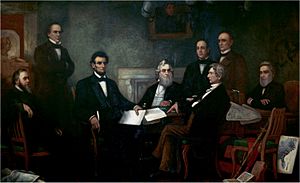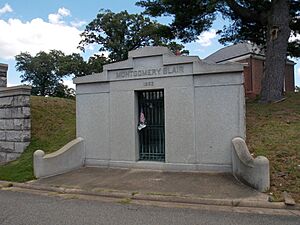Montgomery Blair facts for kids
Quick facts for kids
Montgomery Blair
|
|
|---|---|

Blair, c. 1855-1865
|
|
| 20th United States Postmaster General | |
| In office March 5, 1861 – September 24, 1864 |
|
| President | Abraham Lincoln |
| Preceded by | Horatio King |
| Succeeded by | William Dennison |
| Personal details | |
| Born | May 10, 1813 Franklin County, Kentucky, U.S. |
| Died | July 27, 1883 (aged 70) Silver Spring, Maryland, U.S. |
| Resting place | Rock Creek Cemetery Washington, D.C., U.S. |
| Political party | Democratic (Before 1854; 1865–1883) Republican (1854–1865) |
| Spouses |
Caroline Buckner
(m. 1836; died 1844)Mary Woodbury |
| Children | 4 |
| Parent |
|
| Relatives |
|
| Education | United States Military Academy (BS) Transylvania University (LLB) |
| Signature | |
| Military service | |
| Allegiance | |
| Branch/service | |
| Years of service | 1835–1836 |
| Rank | Second Lieutenant |
| Battles/wars | Seminole Wars |
Montgomery Blair (born May 10, 1813 – died July 27, 1883) was an American politician and lawyer from Maryland. He served in President Abraham Lincoln's team as the Postmaster General from 1861 to 1864. This was during the American Civil War, a very important time in U.S. history.
Contents
Early Life and Education
Montgomery Blair was born in Franklin County, Kentucky. His father, Francis Preston Blair, was a well-known newspaper editor and a key figure in the Democratic Party. As a boy, Montgomery often heard important discussions between his father and President Andrew Jackson.
Blair went to the United States Military Academy at West Point. After serving for one year in the Seminole War, he left the U.S. Army. He then married Caroline Rebecca Buckner and started studying law at Transylvania University in Lexington, Kentucky.
In 1839, Blair began working as a lawyer in St. Louis, Missouri. He served as a United States district attorney there. After his first wife, Caroline, passed away in 1844, he later married Mary Elizabeth Woodbury.
In 1852, Blair moved to Maryland. He focused on practicing law, especially in the Supreme Court of the United States. From 1855 to 1858, he was a U.S. Solicitor in the Court of Claims. He also worked on a very famous case called Dred Scott v. Sandford in 1857.
The Dred Scott Case
Blair was the lawyer for Dred Scott, an enslaved African-American man. Scott had lived with his owner, an army doctor, in free states and territories for a long time. Blair argued that because Scott had lived in free areas like Illinois and Minnesota, he should be a free man.
However, the Supreme Court ruled against Scott. The Court said that Black people, whether enslaved or free, could not be considered American citizens. This decision made the tensions leading to the American Civil War even worse. Even though Blair was considered a conservative on some issues, his work on the Dred Scott case showed he was willing to support more progressive ideas.
Career Highlights
The Blair family, including Montgomery, left the Democratic Party and helped start the new Republican Party. This happened after the Kansas–Nebraska Act, which caused a lot of debate about slavery.
In 1860, Blair strongly supported Abraham Lincoln's campaign for president. After Lincoln won, he chose Blair to be his Postmaster General in 1861. Lincoln wanted Blair, who believed in being firm with the Southern states, to help balance other members of his team who wanted to be more forgiving.
Changes to the Post Office
As Postmaster General, Blair made many important changes:
- He set a single price for postage across the country.
- He started free mail delivery in cities.
- He began selling money orders at post offices. This helped reduce robberies because people didn't have to mail cash.
- He also organized the First International Postal Conference in Paris in 1863. This meeting led to the creation of the Universal Postal Union, which helps countries send mail to each other.
In September 1864, President Lincoln accepted Blair's offer to resign. This might have been because some politicians, called the Radical Republicans, did not like Blair. Even after leaving his job, Blair continued to support Lincoln's re-election. Lincoln and the Blair family remained close friends.
After the Civil War, Blair disagreed with the Republican Party's plans for Reconstruction. He rejoined the Democratic Party, as did his brother, who ran for Vice President in 1868.
In 1876, Blair was a lawyer for Secretary of War William W. Belknap. Belknap was accused of taking illegal payments. Blair asked the committee investigating Belknap to drop the charges if Belknap resigned. Belknap did resign and was later found not guilty by the United States Senate.
In 1882, Blair ran for U.S. Representative from Maryland's sixth district but did not win. His large home in Silver Spring, Maryland, called Falkland, was burned by Confederate soldiers during the Civil War.
Death and Legacy
Montgomery Blair passed away on July 27, 1883, in Silver Spring, Maryland. He had been sick for several years with "inflammation of the spinal membranes," which is a type of meningitis.
His funeral was held at Rock Creek Church, and he was buried at Rock Creek Cemetery. To honor him, the United States Post Office closed on July 30, 1883.
Family Life
Montgomery Blair's wife was Mary Woodbury. They had one daughter, Minnie, and three sons: Woodbury, Gist, and Montgomery Jr., all of whom became lawyers. Montgomery Blair and Mary Woodbury Blair are the great-grandparents of the famous actor Montgomery Clift.
Works and Honors
Blair wrote a speech called Speech on the Causes of the Rebellion in 1864.
Montgomery Blair High School in Silver Spring, Maryland is named after him.
Images for kids
-
Lincoln meeting with his Cabinet for the first reading of the Emancipation Proclamation draft on July 22, 1862





